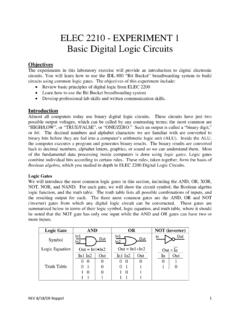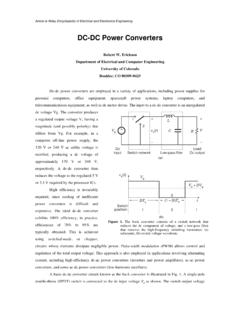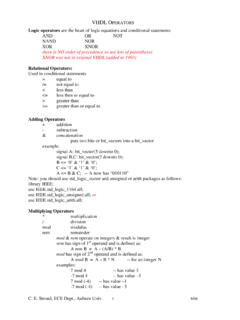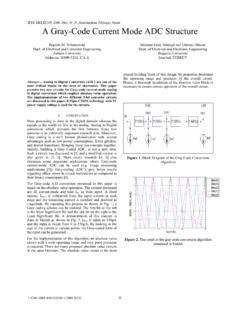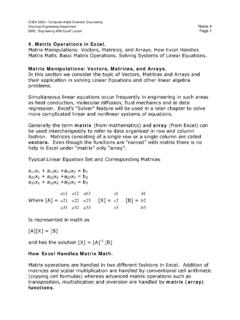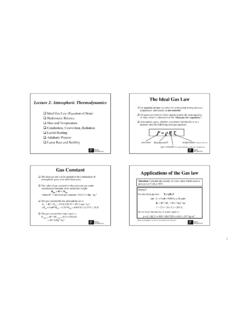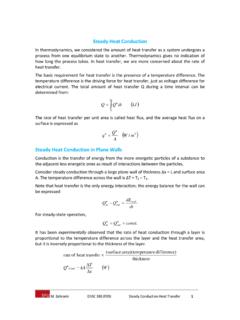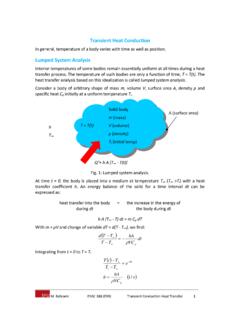Transcription of Radiation Exchange Between Surfaces
1 Chapter 1 Radiation Exchange Between Motivation and ObjectivesThermal Radiation , as you know, constitutes one of the threebasic modes (or mechanisms) of heattransfer, , conduction , convection, and Radiation . Actually, on a physical basis, there are onlytwo mechanisms of heat transfer; diffusion (the transfer of heat via molecular interactions) andradiation (the transfer of heat via photons/electomagnetic waves). Convection, being the bulktransport of a fluid, is not precisely aheattransfer physics of Radiation transport are distinctly differentthan diffusion transport. The latteris alocalphenomena, meaning that the rate of diffusion heat transfer,at a point in space, preciselydepends only on the local nature about the point, , the temperature gradient and thermalconductivity at the point.
2 Of course, the temperature field will depend on the boundary and initialconditions imposed on the system. However, the diffusion heat flux at, say, one point in the systemdoes notdirectlyeffect the diffusion flux at some distant point. Radiation , on the other hand, isnot local; the flux of Radiation at a point will, in general, bedirectly and instantaneously dependenton the Radiation flux at all points in a system. Unlike diffusion, Radiation can act over a , the mathematical description of Radiation transport will employ anintegralequationfor the Radiation field, as opposed to thedifferentialequation for heat objectives in studying Radiation in the short amount of time left in the course will be to1.
3 Develop a basic physical understanding of electromagnetic Radiation , with emphasis on theproperties of Radiation that are relevant to heat Describe Radiation Exchange among Surfaces , in which thesurfaces can be perfect absorbersof Radiation (black) or diffusely absorbing (gray).3. Introduce the topic of Radiation transfer in a participating medium that absorbs, emits, andscatters Radiation , and describe the formulation and application of the radiative 1. Radiation Exchange Between Basic Radiation PropertiesFor our purposes, it is useful to view Radiation as the transport of energy in electromagneticwaves.
4 Radiation can also be viewed as the transport of energy by discrete photons, and the basicrelationship Between the energy of a photon, , and the frequency or wavelength =c/ of thewave is given by Planck s relation; =h =hc ( )wherehis Planck s constant andcis the speed of light in a ( ) indicates that the energy of the Radiation is inversely proportional to the refers to the spectrum of Radiation in the visible( = m)to infrared (IR, = 10 100 m) wavelengths. Radiation at these wavelengths can excitethe rotational and vibrational energy levels of molecules and thus transfer energy to molecules inthe form ofheat.
5 That is, the absorption of thermal Radiation by molecules will act to raise thetemperature of the system. Radiation having shorter wavelengths (UV, x rays, rays) can excitethe electronic energy levels of molecules and atoms and/or ionize or break molecular bonds. Thisspectra of Radiation is often referred to asionizingradiation. On the other hand, longer wavelengths(microwaves, radio waves) will not, in general, couple withthe energy storage levels in molecules;although an obvious exception are the microwave wavelengths used in the common microwave practically all engineering relevant applications, the source of thermal Radiation isthermalemission.
6 All bodies at any finite temperature will emit Radiation . Itwas theoretically establishedby Boltzmann, and experimentally confirmed by Stephan, in the 19th century that the maximumpossible emission rate from a surface is given byeb= T4( )where = 108W/m2K4. The above formula is known as theStephan Boltzmannlaw, andeb, having units of W/m2, is theblackbody emissive power, which depends solely on the absolutetemperatureTof the surface. All real Surfaces will emit Radiation at a rate smaller thaneb; an ideal surface which attained an emission ofebwould be referred to as is possible to construct devices which come very close to meeting the ideal emission of ablackbody.
7 Typically, these devices are formed from an isothermal cavity ( , a hollow sphere),with a small opening from which the Radiation escapes. The Radiation emitted by a blackbody ata specifiedTwill be distributed over wavelength , the spectrum of which will also depend solelyonT. Although the nature of the blackbody spectrum was experimentally known in the late 19thcentury, theoretical prediction of the spectrum defied the classical physical understanding of theday. Planck, at the beginning of the 20th century, used the concept of discrete wavelength energylevels to develop a theoretical prediction of the blackbodyspectrum which was consistent withexperiments.
8 His formula for the spectral blackbody emissive power iseb =C1 5(exp[C2/( T)] 1)( ) BASIC Radiation PROPERTIES310 110010110210 310 210 1100101102103104105106 , meb , W/m2 m1000 K1500 K2000 KFigure : Blackbody spectral power distributionin whichC1= 2 hc2= 108W ( m)4/m2andC2=hc/kB= 14,388 m K. The quantityeb d denotes the energy emitted from the black surface, per unit area, within a wavelength intervald about wavelength . The energy over all wavelengths is obtained fromeb=Z 0eb d = T4( ) , the total emissive power is given by the Stephan Boltzmann law, as it plot ofeb vs. wavelength is given in AsTincreases two things happen: 1) thespectral emissive power at all wavelengths increase, and 2)the wavelength corresponding to themaximum power shifts towards the shorter wavelengths.
9 The value of the wavelength at which themaximum occurs is predicted by the Wien displacement law, max=2898 m KT( )Equation ( ) can be rearranged to identify afractional distirbutionfunction. Assume thatTis constant, then we can write1 T5Z 0eb d( T) = 1( )Now combine with Eq. ( ), and observe that Tbecomes the sole variable of the can therefore definef ( T) =C1/ ( T)5(exp[C2/( T)] 1)( )4 CHAPTER 1. Radiation Exchange Between SURFACESF igure : Intensity definitionso thatf( T) =Z T0f (x)dx( )represents the fraction of emitted energy Between 0 and T, relative to the total emitted previous section identified the blackbody emissive power from a surface, which is a quantitythat has units of W/m2, that is, the same units of a heat flux.
10 The emissive power, however, isnot a heat flux the latter is precisely a vector quantity which can be resolved into directionalcomponents. The emissive power, on the other hand, describes the energy leaving a surface perunit area of the surface; it does not describe the directional characteristics of the Radiation as itleaves the describe the directional properties of Radiation as it propagates through space, we need tointroduce a quantity referred to as the radiationintensity. The intensity, denotedI, is defined byuse of Radiation is emitted from a small surface element Aand travels in all portion of the Radiation lands on the small area element on ahemisphere enclosing A, denotedasdA.

